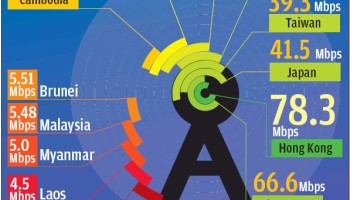 |
|
 |
Launch of State of Households 2018: Different
Realities. From left to right: Datuk Hisham Hamdan, Dr Nungsari Ahmad
Radhi, Allen Ng, Dr Suraya Ismail, Junaidi Mansor.
|
Malaysia's widening income gap
KUALA LUMPUR: The gap in income between the rich, middle class and poor in Malaysia has widened since 2008, according to a study by Khazanah Research Institute (KRI).
In its “The State of Households 2018” report, the research outfit of sovereign wealth fund Khazanah Nasional Bhd noted that the gap in the real average income between the top-20% households (T20) and the middle-40% (M40) and bottom-40% (B40) households in Malaysia has almost doubled compared to two decades ago.
The report, entitled “Different Realities”, pointed out that while previous economic crises in 1987 and the 1997/98 Asian Financial Crisis saw a reduction in the income gap between the T20 and B40/M40, post 2008/09 Global Financial Crisis (GFC), those disparities were not reduced.
But the Gini coefficient, which measures income inequality in the country, had declined from 0.513 in 1970 to 0.399 in 2016, denoting improvement in income inequality in Malaysia over the past 46 years.
Explaining the phenomenon, Allen Ng, who is the lead author of the KRI report, said income of the T20 households had continued to grow, albeit at a slower pace than that of the M40 and B40 since 2010.
“However, because they (the T20) started at a higher base, the income gap between the T20 and M40/B40 had continued to grow despite the fact that the relative (income growth) is actually narrowing post-GFC,” Ng explained at a press conference after the launch of the report here yesterday.
On that note, Ng calls for greater emphasis and investment in human capital to address the income disparities in the country.
“Human capital is the lynchpin that will help us in the next mile of development,” Ng said.
“Based on the work that we have done, and the way we read the issue, the most important equaliser in terms of income inequality is actually human capital. If we don’t address the quality of our education system, we will not be able to solve the problem of income inequality,” he added.
Among the many key issues highlighted in the report, the state of human capital development in Malaysia was noted as a crucial element to complement the country’s transition towards a knowledge-based economy.
“To complement the knowledge-based economy, the state of human capital development in this country – of which 20% of government expenditure goes to education – has plenty of room for improvement,” the report stated.
Worryingly, the report noted that despite Malaysians receiving 12 years of schooling, they receive only nine years’ worth of schooling after adjusting for education quality.
“The central issue of generating high-quality human capital in this country is an important one as the transition to a high-income nation requires human capital levels that continuously improve productivity, sustain growth and are able to create or utilise technological advancements rather than being substituted by it,” the report said.
Meanwhile, KRI also noted that despite the improvement in income inequality and declining poverty rates in Malaysia, poverty in the country remained rampant.
“While the absolute poverty rate has been steadily declining, it is estimated that an additional one million households lived in ‘relative poverty’ in 2016 compared to two decades ago,” it said in its report.- The Star
Malaysia's Lower Income Group Only Has RM76 To Spend A Month After Expenses
Shocking.
 | |
| Some numbers for your soul.- PIC: Department of Statistics Malaysia |
According to The Star Online, these households -- categorised under the bottom 40% (B40) income group in the country because they are earning less than RM2,000 a month -- only have RM76 to spare, after deductions, in 2016.
As comparison, these households have a residual income of RM124 in 2014.
The reason for the sharp decline? They were forced to spend more of their income on household items.
The study revealed that these households are spending 95 per cent of their total income on consumption items in 2016 compared to 2014, when the same households spend 'only' 92 per cent of their income on daily items.
So, what's the cause behind this worrying trend?
The report indicated that the rising cost of living is mainly to be blamed for the increase in household expenditure, so #ThanksNajib.
In fact, the report revealed that the high cost of living has affected not only the B40, but all income groups as well.
The real residual household income has, according to the report, reduced for all income classes. For example, households earning above RM15,000 has a real residual income of RM13,100 in 2016, down from RM14,458 in 2014.
Sigh, we guess we just have to spend our money wisely from now on. No more RM16 Caramel Frappuccino® from Starbucks from now on.
Money, where did you go?
We know we keep saying that we're broke, but after reading this report, we found out that there are a lot of people out there who are having it worse than us.A recent Khazanah Research Institute (KRI) study revealed that every month, the average lower-income household in Malaysia has barely enough to survive after household expenses are deducted.
It's, like, really, really bad!
Related:
We need a complete overhaul of our education system, says NUTP - Nation
Malaysia's widening income gap between rich and poor - Business ...

More women at work narrows gender gap
Woman loses RM1.2mil to scammers 'investigating' her for money laundering
Related posts:































